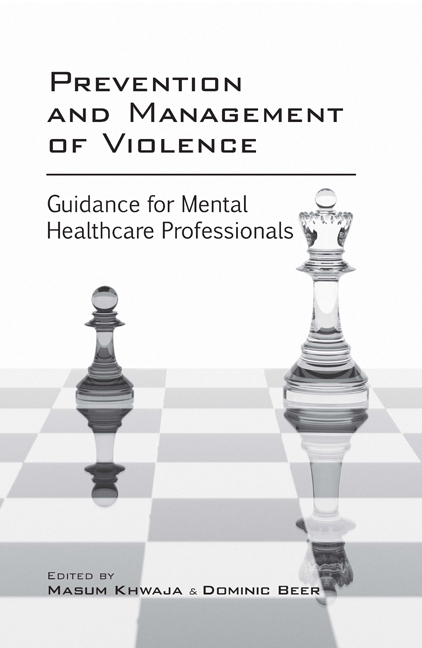Book contents
- Frontmatter
- Dedication
- Contents
- Abbreviations
- List of boxes and tables
- Working group
- Executive summary and recommendations
- 1 Legislation relevant to the management of violence by persons with mental disorders
- 2 Safeguarding vulnerable adults and children exposed to violence
- 3 Risk assessment and management
- 4 Risk prevention and non-pharmacological management of violence in acute settings
- 5 Use of medication and ECT in the management of violence
- 6 Post-incident management
- 7 Management of the risk of violence in the community
- 8 Management of violence in older adults
- 9 Management of violence in people with intellectual disability
- 10 Management of violence in prisons
- 11 Liaison with the police, Crown Prosecution Service and MAPPA
- 12 Information-sharing with victims of crime committed by persons with mental disorders
- 13 Clinical governance
- Appendix Organisations that victims of crime can contact
- Index
4 - Risk prevention and non-pharmacological management of violence in acute settings
- Frontmatter
- Dedication
- Contents
- Abbreviations
- List of boxes and tables
- Working group
- Executive summary and recommendations
- 1 Legislation relevant to the management of violence by persons with mental disorders
- 2 Safeguarding vulnerable adults and children exposed to violence
- 3 Risk assessment and management
- 4 Risk prevention and non-pharmacological management of violence in acute settings
- 5 Use of medication and ECT in the management of violence
- 6 Post-incident management
- 7 Management of the risk of violence in the community
- 8 Management of violence in older adults
- 9 Management of violence in people with intellectual disability
- 10 Management of violence in prisons
- 11 Liaison with the police, Crown Prosecution Service and MAPPA
- 12 Information-sharing with victims of crime committed by persons with mental disorders
- 13 Clinical governance
- Appendix Organisations that victims of crime can contact
- Index
Summary
When the Zero Tolerance campaign against violence in the NHS was launched in 1999, very few people thought it would relate to mental health services. However, the campaign was timely and coincided in a movement towards not accepting violence as an everyday, unavoidable reality of mental health services. This change in values has seen an increase in the belief that more can and should be done to reduce the rates of violence and aggression. Although services may not be able to stop or anticipate all incidents of violence, they certainly should not tolerate violent behaviour.
In addition, we would reiterate that effective risk assessment and management prior to imminent violence is vital in prevention. Evidence from randomised controlled trials is emerging, showing that aggressive incidents can be reduced significantly through structured risk assessment (van de Sande et al, 2011; Abderhalden et al, 2008).
Prevention of violence
Containment v. Engagement
Traditional thinking has often included the notion that increasing containment interventions by staff and restrictive regimes produces safer environments and decreases disturbance. In contrast to this logic, Bowers et al (2006) in a multicentre study in several European cities found that the delivery of ‘containment’ interventions by staff did not produce a proportional reduction in disturbance. Positive engagement over observation and activity over boredom are being increasingly recognised as highly effective concepts in producing dramatically reduced levels of aggression.
Any successful method of engagement over containment needs to include a strong emphasis on a programme of structured activity in conjunction with an appropriate risk assessment. This should be delivered in a consistent fashion and facilitated both on and away from the ward environment. Successful interaction and positive engagement within a framework and in a setting that allows for safe observation are key characteristics central to reducing violent incidents. Ward regimes
In 1999, the Standing Nursing and Midwifery Advisory Committee produced a report in response to published and damming accounts of boredom and inactivity in mental health in-patient hospitals, and gave persuasive accounts of how this is related to disturbance. Subsequent guidance from NICE, the Royal College of Psychiatrists, the Department of Health and Star Wards has recommended the provision of recovery-focused meaningful activity in mental health in-patient settings (Department of Health, 2001; National Institute for Health and Clinical Excellence, 2005; Janner, 2006; Cresswell & Beavon, 2010).
- Type
- Chapter
- Information
- Prevention and Management of ViolenceGuidance for Mental Health Professionals, pp. 18 - 34Publisher: Royal College of PsychiatristsFirst published in: 2017

